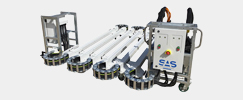Selecting the correct model of GPU can sometimes be a confusing task. It’s essential that the GPU you select for starting turbines and for providing sufficient power for pre-flight checks, provides the performance and product lifespan that you need. Powervamp is a world-renowned ground power unit manufacturer for the aviation industry since 1993. We’re also experts in providing services like emergency lighting products and aircraft static inverters.
The following checklist has been specifically designed to assist Powervamp customers with their GPU selection. Of course, Powervamp’s technical support department or appointed distributors will also be pleased to offer advice in helping you select the correct GPU.
Index
Need help to start your 12V aircraft?
12V GA Pack. Perfect for starting all 12V DC piston engines.
 |
|
Features:
- 2400 peak amps
- Sealed lead acid AGM batteries
- Cleared for air transportation
- External charger with LED status
- Tough polyethylene case
- 3 LED battery charge status
- USB socket for phone/tablet charging
- Output key isolator switch
|
Operating a small airfield?
12/24 GA Pack. Ideal for all 12V & 24V DC piston engines and small turbines. Can also be used on airfield support vehicles.
 |
|
Features:
- 2400 peak amps
- Sealed lead acid AGM batteries
- Cleared for air transportation
- External charger with LED status
- Tough polyethylene case
- 3 LED battery charge status
- USB socket for phone/tablet charging
- External 750A output fuse
|
Is the pack for emergency use only?
GPU1700. A GPU with minimum capacity may be sufficient, as it is unlikely to encounter intense usage.
 |
|
Features:
- 1700 peak amps
- Sealed lead acid AGM batteries
- Cleared for air transportation
- Internal chargers with LED status
- All-welded stainless steel case
- Solid state voltmeter
- Auxiliary socket for charging
- Security ‘R’ clip isolator lock
|
Running a flight training school?
GPU1700 Twin. Built for multiple starts on light aircraft such as the Cessna 175. Perfect for the first start of the day.
 |
|
Features:
- 3400 peak amps
- Sealed lead acid AGM batteries
- Cleared for air transportation
- Internal chargers with LED status
- All-welded stainless steel case
- Solid state voltmeter
- Auxiliary socket for charging
- Security ‘R’ clip isolator lock
|
Will the GPU be used for programming/pre-flight checks before spool-up?
GPU2400. Allow additional amp/hr capacity to ensure a cool start.
 |
|
Features:
- 2450 peak amps
- Sealed lead acid AGM batteries
- Cleared for air transportation
- Internal chargers with LED status
- All-welded stainless steel case
- Solid state voltmeter
- Auxiliary socket for charging
- Security ‘R’ clip isolator lock
|
Offshore platform or heli-deck?
GPU2400 Twin. Best option for the variety of large twin engine helicopters utilised in this sector.
 |
|
Features:
- 4900 peak amps
- Sealed lead acid AGM batteries
- Cleared for air transportation
- Internal chargers with LED status
- All-welded stainless steel case
- Solid state voltmeter
- Auxiliary socket for charging
- Security ‘R’ clip isolator lock
|
Will the pack be carried on board?
Coolspool 17. You’ll need to consider the weight of the unit, but beware of reducing weight at the cost of performance.
 |
|
Features:
- 1600 peak amps
- Sealed lead acid AGM batteries
- Cleared for air transportation
- Internal chargers with LED status
- Light aluminium case with carry handle
- Solid state voltmeter
- Auxiliary/accessory socket
- Available in 26V or 28V DC versions
|
Large twin turbine engine?
Coolspool 29. Increased performance when compared to a 24V DC unit, resulting in cooler starts.
 |
|
Features:
- 2400 peak amps
- Sealed lead acid AGM batteries
- Cleared for air transportation
- Internal chargers with LED status
- Aluminium case with carry handle
- Solid state voltmeter
- Auxiliary/accessory socket
- Available in 26V or 28V DC versions
|
Multiple starts or pre-flight checks required?
Coolspool 29 Twin. Provides high performance, and with a 52 amp/hour capacity makes it an independent power source.
 |
|
Features:
- 4800 peak amps
- Sealed lead acid AGM batteries
- Cleared for air transportation
- Internal chargers with LED status
- Aluminium case with carry handle
- Solid state voltmeter
- Auxiliary/accessory socket
- Available in 26V or 28V DC versions
|
Will the GPU be used for regular avionics or maintenance work?
GPU1500/40. Batteries are not designed for the continuous powering of avionics. Consider a GPU with internal power supply.
 |
|
Features:
- 2400 peak amps
- Sealed lead acid AGM batteries
- Cleared for air transportation
- Dual internal chargers with LED status
- 40A continuous power supply
- Aluminium case with carry handle
- Solid state voltmeter
- Auxiliary/accessory socket
|
Is engine free turbine or shaft turbine/turboprop?
GPU1500/40 Twin. Longer spool-up times of shaft turbines will require more amp/hr capacity.
 |
|
Features:
- 4800 peak amps
- Sealed lead acid AGM Batteries
- cleared for air transportation
- Dual internal chargers with LED status
- 80A continuous power supply
- Aluminium case with carry handle
- Solid state voltmeter
- Auxiliary/accessory sockets
|
Will the GPU be used as the main ramp/hangar GPU on multiple operations?
Coolspool 130. It’s best to extend the GPU life with extra amp/hour capacity.
 |
|
Features:
- 4000 peak amps
- Sealed lead acid AGM batteries
- Cleared for air transportation
- 75A / 28V DC continuous power supply
- Solid state ammeter
- Solid state voltmeter
- Removable tow arm
- Heavy duty push/pull isolator
|
Is the GPU required for regular compressor washing?
Coolspool 260. It’s likely the battery will need replacing regularly if using a small pack.
 |
|
Features:
- 8000 peak amps
- Sealed lead acid AGM batteries
- Cleared for air transportation
- 75A / 28V DC continuous power supply
- Solid state ammeter
- Solid state voltmeter
- Removable tow arm
- Heavy duty push/pull isolator
|
How many engine starts are required before the GPU can be re-charged?
Coolspool 410. Starts require amp/hr capacity to maintain volts. More starts require more amp/hr capacity and more weight, and therefore a larger cart.
 |
|
Features:
- 4700 peak amps
- Sealed lead acid AGM batteries
- Cleared for air transportation
- 75A / 28V DC continuous power supply
- Solid state voltmeter
- Solid state ammeter
- Removable tow arm
- Heavy duty push/pull isolator
|
No mains electrical supply?
Coolspool Hybrid 300. This unit combines a diesel driven 300A power supply for continuous use & 4 x 225A batteries for engine starts. It can also be connected to a suitable mains power supply for silent operation in the hangar.
 |
|
Features:
- 5000 peak amps
- 300A continuous current
- Support 24V/26V and 28.5V DC systems
- Instant turbine starting power exceeding 2000 amps
- Hangar feature without diesel operation
- Emission compliant Kubota engine
- 110V/230V 50/60Hz power outlet
- -20 to +50°C operating range
|
Need 14V or 28V hangar power for maintenance & avionics updates?
PS30. With its 14/28V DC switchable capabilities, this power supply will power the majority of light aircraft, including small/medium sized helicopters.
 |
|
Features:
- 30A at 14V DC / 28V DC continuous power
- Solid state voltmeter
- Protective jacket included
- Short circuit / current limit protection
- Mains on/off switch
- Power supply LED status indicators
- Rubber, anti-slip, shock absorbent feet
- Light aluminium case with handle
|
PS50M. Alternatively the PS50 is the ideal solution for the majority of light aircraft, including small/medium sized helicopters.
 |
|
Features:
- 50A / 28V DC continuous power
- Solid state voltmeter
- Protective jacket included
- Short circuit / current limit protection
- Mains on/off switch
- Power supply LED status indicators
- Rubber, anti-slip, shock absorbent feet
- Light aluminium case with handle
|
PS100. For larger aircraft choose the more powerful 100A power supply.
 |
|
Features:
- 100A / 28V DC continuous power
- Solid state voltmeter
- Solid state ammeter
- Short circuit / current limit protection
- 28V DC accessory socket
- Power supply LED status indicators
- Rubber, anti-slip, shock absorbent feet
|
PS300. For aircraft with air conditioning, and other power hungry requirements, the PS300 ideal.
 |
|
Features:
- 300A / 28V DC continuous power
- Solid state voltmeter
- Solid state ammeter
- Lightweight aluminium case with handle
- Short circuit / current limit protection
- Emergency stop push button
- Power supply LED status indicators
- Rubber, anti-slip, shock absorbent feet
|
Still unsure on the correct GPU?
Allow our Ground Power Selector to make the choice for you.
Select the manufacturer and model of your aircraft. The Ground Power Selector will recommend the most suitable starter unit & power supply.
Disclaimer
The information and data within this brochure regarding pack size, performance and engine models is given in good faith as a guide only. The company accepts no responsibility for errors and omissions. Selecting any portable GPU is not an exact science. It is a compromise between weight, size, necessary performance, recharge time, battery life and price. It should be noted that the life of the GPU is dependent on the level of discharge each time the GPU is used. The deeper the discharge, then the sooner will be the time when batteries need replacing. Where possible it is always preferable and more cost effective to buy a GPU with the maximum amp/hr capacity.













































